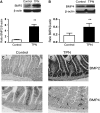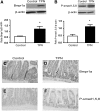The bone morphogenetic protein signaling pathway is upregulated in a mouse model of total parenteral nutrition
- PMID: 19498022
- PMCID: PMC2696986
- DOI: 10.3945/jn.108.096669
The bone morphogenetic protein signaling pathway is upregulated in a mouse model of total parenteral nutrition
Abstract
Total parenteral nutrition (TPN) results in intestinal mucosal atrophic changes due to an absence of enteral nutrition; however, the mechanisms responsible for this are not fully understood. It has been shown that bone morphogenetic protein (BMP) activation inhibits intestinal epithelial cell (EC) proliferation. Therefore, we hypothesized that the BMP pathway could be upregulated by TPN. To address this, we randomly assigned mice to receive TPN or to be enterally fed (control) for 7 d. Mucosal EC isolates were harvested from the entire length of small intestine for RNA and protein measurements. Full-thickness, mid-small bowel was processed for histological examination. TPN increased the abundance of BMP2, BMP4, and BMP type II receptor at the RNA and protein levels. Phosphorylation of Smad1, Smad5, and Smad8 also was greater in the TPN group than in the control, which helped to confirm activation of this pathway. Interestingly, the TPN and control groups did not differ in the mRNA expression of the extracellular soluble bmp antagonists, noggin, gremlin, chordin, or follistatin. Compared to the control group, the expression of c-Myc (cellular myelocytomatosis) mRNA was lower, whereas the level of p21(WAF1/CIP1) was greater, in the TPN group. Because the BMP family may function through suppression of Wnt-beta-catenin signaling, this pathway was also examined. mRNA expression of Wnt 3, Wnt5a, and the Wnt receptor Lrp5 were lower in the TPN group compared to controls. The results suggest that the BMP signaling pathway may be involved in the development of intestinal mucosal atrophy due to TPN administration.
Figures




Similar articles
-
Bone morphogenetic protein-2 and -4 limit the number of enteric neurons but promote development of a TrkC-expressing neurotrophin-3-dependent subset.J Neurosci. 2004 Apr 28;24(17):4266-82. doi: 10.1523/JNEUROSCI.3688-03.2004. J Neurosci. 2004. PMID: 15115823 Free PMC article.
-
Bone morphogenetic proteins.Growth Factors. 2004 Dec;22(4):233-41. doi: 10.1080/08977190412331279890. Growth Factors. 2004. PMID: 15621726 Review.
-
Decreased phospho-Akt signaling in a mouse model of total parenteral nutrition: a potential mechanism for the development of intestinal mucosal atrophy.Am J Physiol Gastrointest Liver Physiol. 2010 Jun;298(6):G833-41. doi: 10.1152/ajpgi.00030.2010. Epub 2010 Mar 18. Am J Physiol Gastrointest Liver Physiol. 2010. PMID: 20299605 Free PMC article.
-
Expression of bone morphogenetic protein 2, 4, and related components of the BMP signaling pathway in the mouse uterus during the estrous cycle.J Zhejiang Univ Sci B. 2014 Jul;15(7):601-10. doi: 10.1631/jzus.B1300288. J Zhejiang Univ Sci B. 2014. PMID: 25001220 Free PMC article.
-
Control of BMP gene expression by long-range regulatory elements.Cytokine Growth Factor Rev. 2009 Oct-Dec;20(5-6):509-15. doi: 10.1016/j.cytogfr.2009.10.011. Epub 2009 Nov 8. Cytokine Growth Factor Rev. 2009. PMID: 19900834 Free PMC article. Review.
Cited by
-
The interplay of BMP4 and IL‑7 regulates the apoptosis of intestinal intraepithelial lymphocytes under conditions of ischemia̸reperfusion.Int J Mol Med. 2018 May;41(5):2640-2650. doi: 10.3892/ijmm.2018.3480. Epub 2018 Feb 9. Int J Mol Med. 2018. PMID: 29436597 Free PMC article.
-
Intestinal mucosal barrier is injured by BMP2/4 via activation of NF-κB signals after ischemic reperfusion.Mediators Inflamm. 2014;2014:901530. doi: 10.1155/2014/901530. Epub 2014 Jul 16. Mediators Inflamm. 2014. PMID: 25132736 Free PMC article.
-
Loss of ADAM17-Mediated Tumor Necrosis Factor Alpha Signaling in Intestinal Cells Attenuates Mucosal Atrophy in a Mouse Model of Parenteral Nutrition.Mol Cell Biol. 2015 Nov;35(21):3604-21. doi: 10.1128/MCB.00143-15. Epub 2015 Aug 17. Mol Cell Biol. 2015. PMID: 26283731 Free PMC article.
-
Homeostasis alteration within small intestinal mucosa after acute enteral refeeding in total parenteral nutrition mouse model.Am J Physiol Gastrointest Liver Physiol. 2016 Feb 15;310(4):G273-84. doi: 10.1152/ajpgi.00335.2015. Epub 2015 Dec 3. Am J Physiol Gastrointest Liver Physiol. 2016. PMID: 26635320 Free PMC article.
-
Paneth cells inhibit intestinal stem cell proliferation through the bone morphogenic protein 7 pathway under rotavirus-mediated intestinal injury.World J Gastroenterol. 2025 Jul 14;31(26):107044. doi: 10.3748/wjg.v31.i26.107044. World J Gastroenterol. 2025. PMID: 40678707 Free PMC article.
References
-
- Yang H, Antony PA, Wildhaber BE, Teitelbaum DH. Intestinal intraepithelial lymphocyte gammadelta-T cell-derived keratinocyte growth factor modulates epithelial growth in the mouse. J Immunol. 2004;172:4151–8. - PubMed
-
- Wildhaber BE, Yang H, Spencer AU, Drongowski RA, Teitelbaum DH. Lack of enteral nutrition–effects on the intestinal immune system. J Surg Res. 2005;123:8–16. - PubMed
-
- Massagué J. TGF-beta signal transduction. Annu Rev Biochem. 1998;67:753–91. - PubMed
-
- He XC, Zhang J, Tong WG, Tawfik O, Ross J, Scoville DH, Tian Q, Zeng X, He X, et al. BMP signaling inhibits intestinal stem cell self-renewal through suppression of Wnt-beta-catenin signaling. Nat Genet. 2004;36:1117–21. - PubMed
-
- Haramis AP, Begthel H, van den Born M, van Es J, Jonkheer S, Offerhaus G, Clevers H. De novo crypt formation and juvenile polyposis on BMP inhibition in mouse intestine. Science. 2004;303:1684–6. - PubMed
Publication types
MeSH terms
Substances
Grants and funding
LinkOut - more resources
Full Text Sources
Other Literature Sources
Molecular Biology Databases
Research Materials

